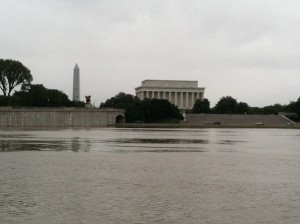Full of hidden treasures: a phrase I would use to describe both the Potomac and James Rivers. Beautiful, a teacher, and full of opportunities are also words to describe these two important rivers.
During Fall Break this past weekend, Earth Lodge members went on a boat ride on the Potomac River around Washington, D.C. to learn about the history, health, and uses of the Potomac River watershed. Though it has its own unique characteristics, the Potomac is quite similar to the James River watershed which we have been studying for many weeks up to this point.
Some obvious similarities are the rivers’ importance during the colonization of America and during the Civil War. The national capital was built on the Potomac because of the resources the waterway could provide. The James River was colonized for similar reasons and Richmond serves as the capital city of the commonwealth of Virginia. Both rivers were exploited for their resources and were neglected in the way of protecting the rivers’ health. It was not until much damage was done to each river that citizens began to realize the consequences of the urbanization. Now, both rivers face their own set of serious issues and there are many efforts and organizations that are trying to repair the rivers back to good health.
“We’re going to break into groups and test some different abiotic factors of the water,” explained one of the Chesapeake Bay Foundation leaders to us when we stopped near the Washington, D.C. wastewater treatment plant. Memories of doing this in high school immediate flooded my mind, but I had to take a moment to think what we could possibly expect to see as the health of this river. Dissolved oxygen, turbidity, nitrates, temperature, and salinity were among some of the abiotic factors we tested and compared to another spot near the deeper section of the upper Potomac. Some aspects were better than expected, like dissolved oxygen and pH, while others were worrisome, like phosphates, nitrates, and turbidity. We have not specifically tested the water of the James for these factors, but one can hypothesize that the health is at a similarly low level due to a serious problem with nitrate, phosphate, and sediment input into the James River.
Another factor of river health, biodiversity, was tested when we set out a trawl net to catch fishes and marine animals along the bottom of the river. Eric, one of the CBF leaders made a remark that it was the worst day of fishing he had seen all year. To that end, we discussed why this could be: a large rainstorm, the first in a month and a half, had just impacted the river days before and could have sent the river and its inhabitants into a bit of chaos. Like the James River though, large rainstorms heavily impact the Potomac due to a startling lack of riparian buffer, a result of the building of a city along its banks. The water of both the James and Potomac become very murky as the sediment is churned and polluted water rushes into the river.
We spent a good amount of time in various parts of the Chesapeake Bay Watershed in the last 2 months and one conclusion I can say with certainty is that the bay and its watershed are beautiful treasures that must be protected. The James and Potomac River are both important spots for recreation and serve as a classroom to teach biology and the need for environmental conservation to anyone who will listen. Though you can’t see nitrates and other pollutants at the surface of a river, you also can’t see the wonderful treasures like oysters, game fish, and Diamondback Terrapins that lie within those polluted waters. It is only by hearing about what the rivers used to be and seeing what they are like now that we can start to understand the magnitude of impact humans have made. And then we can begin to work towards more sustainable and healthy habits of interacting with these, and all other, rivers.


